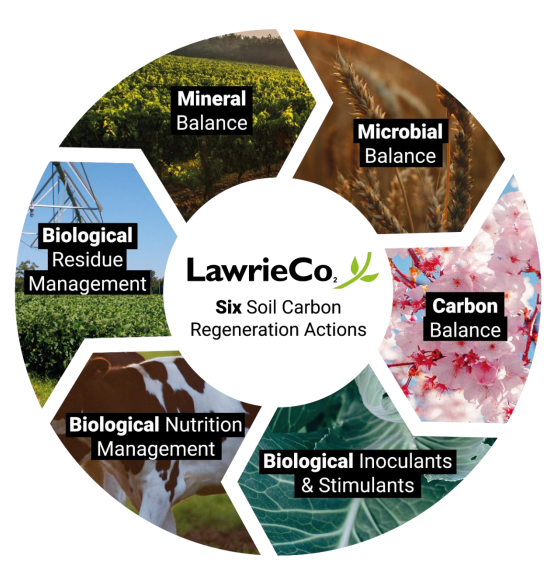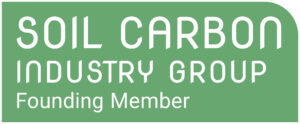Soil Carbon
your soil quality
LawrieCo is proud to be a foundation member of the Soil Carbon Industry Group (SCIG), a leading organisation dedicated to accelerating the development of the soil carbon farming industry. LawrieCo, partnered with SCIG aims to facilitate carbon drawdown and advocating for practices that improve soil health and mitigate climate change primarily in farming systems. Through our ongoing collaboration with SCIG, LawrieCo remains committed to finding innovative solutions for a more sustainable future.
How does it work?
Our End-To End Carbon Farming Solution:
- Easy to join, No /Low cost to enter,
- No ongoing testing or Audit costs
- Mitigates future risk of carbon losses
- Strategic project area registration to maximise credits returned
- Easy to use farm nutrition programs / products to build your soil carbon levels
- Keeps your land in production – Not locked up
- Satellite monitoring of soil carbon stocks
- Hold your carbon credits to offset farm emissions
- Or trade your carbon credits when it suits you
- Retain all of the benefits extra soil carbon has for your farm – Increased moisture / nutrient holding capacity, farm productivity, soil & plant health.

Enter your details to download your copy of LawrieCo’s 6 Step summary and Carbon Builders overview
LawrieCo’s Soil Carbon Regeneration System Incorporates biological applied science and regenerative bio fertilisers. It’s the science that makes building soil carbon possible. Our 22+ years of Research and Product Development has culminated in a suite of products that support soil carbon regeneration whilst maintaining / boosting the productivity of your enterprise.
Our carbon crediting program is world class connecting growers with rigorous the Federal Government Emission Reduction Fund, ensuring the viability of credits issued.
Pioneers in building Soil Carbon
LawrieCo’s passion for rebuilding soil carbon dates back to prior to the formation of LawrieCo as a company. Back to the days when the ‘R&D’ to farm sustainably and to build fertility happened on Adrian Lawrie’s broadacre cropping property on the edge of the Flinders Ranges. At this early stage the key drivers for rebuilding soil carbon were its value in building fertility, water-use efficiency and it’s link to improved farm gross margins.
Over the past 22 years, LawrieCo has evolved to offer a full range of fertility and soil carbon building programs in broadacre, grazing, turf and horticultural enterprises. Allowing landowners to adopt regenerative soil and plant nutrition practices and to participate in the Federal Governments paid soil carbon credit program – The Emissions Reduction Fund (ERF). In recent years the barriers to entry to participating in the ERF for growers building soil carbon have been removed and the accessibility continues to further develop.
In the meantime the movement into regenerative Ag is gaining much momentum and the adoption of carbon saving or carbon building practice like ‘no-till’ has become a goal for many growers, who are realising the value of soil carbon for it’s water holding properties.
Now is a great time to adopt LawrieCo’s regenerative nutrition practices and commence building soil carbon for improved farm productivity and consider joining the ERF scheme for a second income stream.
Building Soil Carbon in Broadacre Cropping – Shepparton Vic
Learn more about establishing your soil carbon project
Our History with Soil Carbon
Why start a project?
What are the benefits?
What is the financial return?
What are the downsides?
What are the common misconceptions?
How to build soil carbon
Land Management practices improving soil health
Soil Organic Carbon is Profitable
CSIRO Land and Water report indicates Soil Organic Carbon Levels impact on Farm Gross Margin Profit – Wagga Wagga NSW.
Multiple Soil Organic Carbon tests were taken from 35 properties and correlated with GM Profit.
1% SOIL ORGANIC CARBON – $160 / GM PROFIT
2% SOIL ORGANIC CARBON – $380 / GM PROFIT

Soil Health, Carbon Decline and Microbial Imbalance
Victorian DPI Walpeup Research station shows a decline in key soil health parameters including microbial imbalances over 80 years.

In 1925: Soil health in 1925 was close to ideal as assessed by the soil health assessments (70-90% of optimal). Important soil microbes Active Bacteria : Active Fungi were in ideal ratios to each other (1:1)
By 2005: The soil health assessments have declined to 20-40% of the optimal levels. Active Fungi have declined to less than 50% of optimum whereas Active Bacteria have increased to 200% of optimum
Soil health decline impacts on productivity:
Until 1960, soil Carbon Bacteria & Fungi were at good levels and their relative ratio was ideal. Alarmingly in 2005 Fungi levels are now only 10% of Bacteria, i.e. F1 : B10. This represents a severe loss of soil health, impacting on the soil’s water holding capacity, structure and plant resilience in low rainfall years.

Subscribe to our E-News


